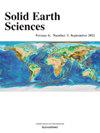Implications for provenance and tectonic setting of the Middle–Late Mesozoic clastic sedimentary rocks in the Nanling Region, South China
IF 2
4区 地球科学
Q3 GEOSCIENCES, MULTIDISCIPLINARY
引用次数: 0
Abstract
The South China Block (SCB) hosts numerous economically significant granite-related uranium deposits and critical metal mineralization, notably in the Nanling Region. This study investigates the petrogenesis, provenance, tectonic setting, and potential link to uranium mineralization of Middle–Late Mesozoic clastic sedimentary rocks from the Fengzhou Basin and surrounding areas, SCB. Field and petrographic observations reveal litharenite, arkose, and wacke, mostly cryptocrystalline and variably colored, alongside granoblastic-textured quartz sandstones, purple-red mudstones, and conglomerates dominated by granitic lithic fragments. Whole-rock geochemistry and detrital zircon U–Pb ages were used to interpret source weathering, provenance and source rock composition, and tectonic setting. Major and trace element ratios (e.g., ACNK, CIA, CIW, ICV, Th/U vs. Th) indicate moderate to intense weathering in sandstone and mudstone sources, but weaker weathering for conglomerates. Geochemical proxies (e.g., Al2O3 vs. TiO2, La-Th-Sc, V-Ni-Th∗10, La/Yb vs. REE, La/Th vs. Hf, Th/Sc vs. Zr/Sr, REE patterns) suggest a dominantly felsic source, consistent with the Upper Continental Crust, with minor intermediate input. Detrital zircons yield concordant ages from ca. 2696 to 177 Ma, clustering into four age groups of 2696–2202 Ma, 1989–1087 Ma, 938–433 Ma, and 252–177 Ma, aligning with regional magmatic episodes and sedimentary units in the Nanling and Jiangnan orogens, Wuyi, and Yunkai domains. Tectonic discrimination diagrams using geochemical proxies (e.g., K2O/Na2O vs. SiO2, DF1 vs. DF2, La-Th-Sc, Th-Sc-Zr/10 and Th-Co-Zr/10), along with the detrital zircon dating, suggest deposition occurred in a transitional setting, likely a back-arc or post-orogenic basin, marking a shift from compressional to extensional regimes between the Middle Jurassic to Late Cretaceous. Elevated REE, U, Th, and high U/Th, Rb/Sr, and Rb/Ba ratios, along with granite-derived lithic fragments, suggest provenance from uranium-enriched felsic sources, highlighting a genetic link between clastic sedimentation and regional granitoid-related uranium mineralization.
南岭地区中晚中生代碎屑沉积岩物源及构造背景意义
华南地块(SCB)拥有许多具有经济意义的花岗岩相关铀矿床和关键金属矿化,特别是在南岭地区。本文研究了山东丰州盆地及周缘中晚中生代碎屑沉积岩的成因、物源、构造背景及其与铀矿化的潜在联系。野外和岩石学观察显示,岩屑岩、长石和砾岩,大多隐晶且颜色多变,旁边是花岗质构造的石英砂岩、紫红色泥岩和以花岗质岩屑为主的砾岩。利用全岩地球化学和碎屑锆石U-Pb年龄解释烃源岩风化、物源和烃源岩组成以及构造背景。主微量元素比值(ACNK、CIA、CIW、ICV、Th/U / Th)表明,砂岩和泥岩源区风化程度中等至强烈,砾岩源区风化程度较弱。地球化学指标(如Al2O3 vs. TiO2, La-Th-Sc, V-Ni-Th * 10, La/Yb vs. REE, La/Th vs. Hf, Th/Sc vs. Zr/Sr, REE模式)表明其主要来源为长硅质,与上大陆地壳一致,中间输入较少。碎屑锆石年龄约为2696 ~ 177 Ma,可划分为2696 ~ 2202 Ma、1989 ~ 1087 Ma、938 ~ 433 Ma和252 ~ 177 Ma 4个年龄群,与南岭、江南造山带、武夷、云凯域的区域岩浆幕式和沉积单元一致。利用地球化学指标(如K2O/Na2O vs. SiO2, DF1 vs. DF2, La-Th-Sc, Th-Sc-Zr/10和Th-Co-Zr/10)的构造判别图,以及碎屑锆石定年,表明沉积发生在过渡性背景下,可能是弧后或造山后盆地,标志着中侏罗统至晚白垩世从挤压向伸展的转变。高REE、U、Th和高U/Th、Rb/Sr和Rb/Ba比值,以及花岗岩衍生的岩屑碎屑,表明物源来自富铀的长石岩源,突出了碎屑沉积与区域花岗岩相关铀矿化之间的成因联系。
本文章由计算机程序翻译,如有差异,请以英文原文为准。
求助全文
约1分钟内获得全文
求助全文
来源期刊

Solid Earth Sciences
GEOSCIENCES, MULTIDISCIPLINARY-
CiteScore
3.60
自引率
5.00%
发文量
20
审稿时长
103 days
 求助内容:
求助内容: 应助结果提醒方式:
应助结果提醒方式:


